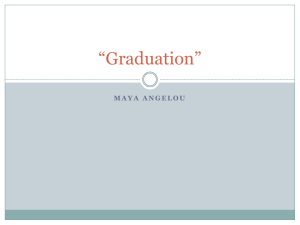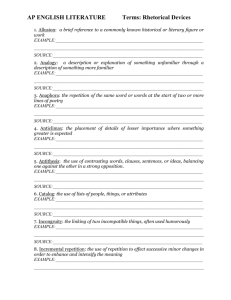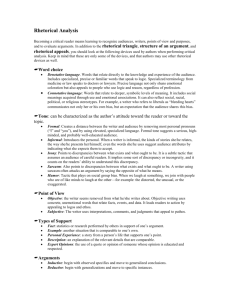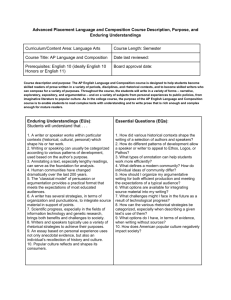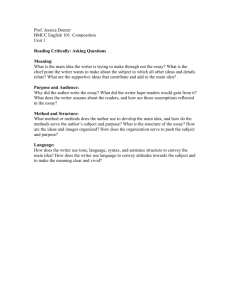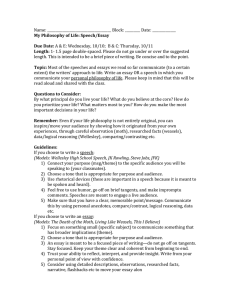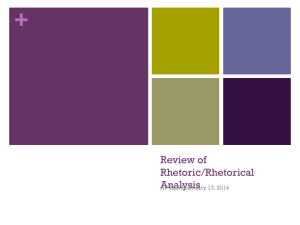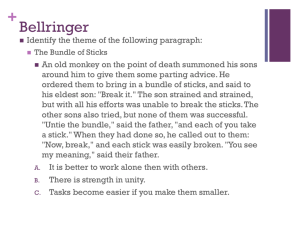Essay Writing: Argument, Tone & Rhetorical Devices
advertisement
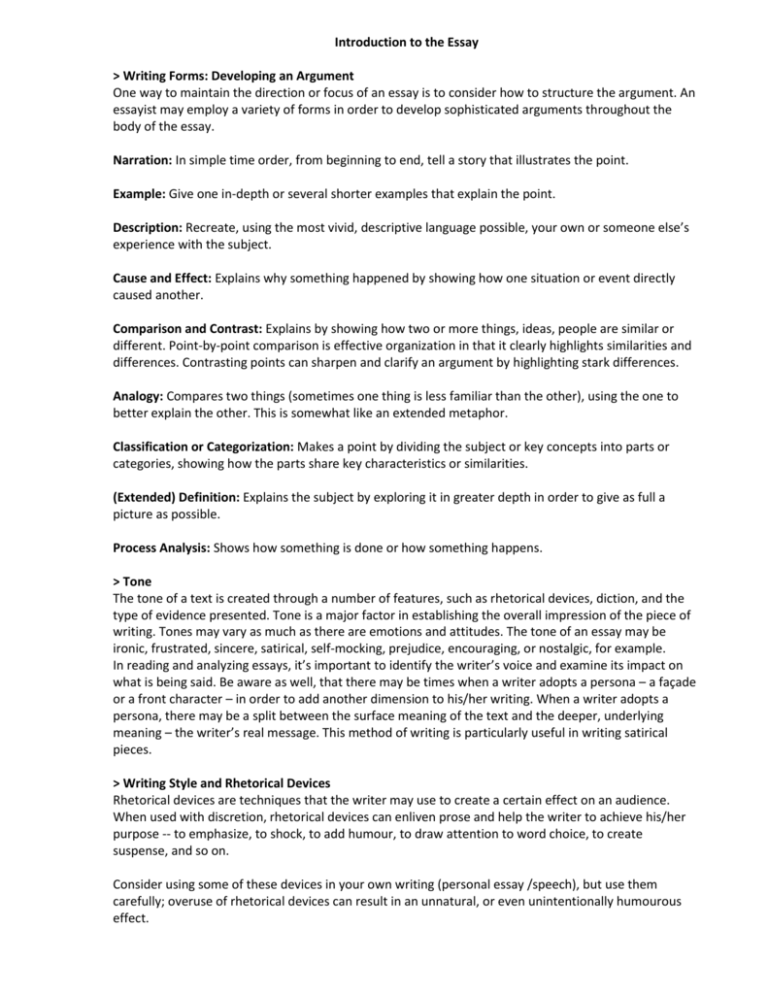
Introduction to the Essay > Writing Forms: Developing an Argument One way to maintain the direction or focus of an essay is to consider how to structure the argument. An essayist may employ a variety of forms in order to develop sophisticated arguments throughout the body of the essay. Narration: In simple time order, from beginning to end, tell a story that illustrates the point. Example: Give one in-depth or several shorter examples that explain the point. Description: Recreate, using the most vivid, descriptive language possible, your own or someone else’s experience with the subject. Cause and Effect: Explains why something happened by showing how one situation or event directly caused another. Comparison and Contrast: Explains by showing how two or more things, ideas, people are similar or different. Point-by-point comparison is effective organization in that it clearly highlights similarities and differences. Contrasting points can sharpen and clarify an argument by highlighting stark differences. Analogy: Compares two things (sometimes one thing is less familiar than the other), using the one to better explain the other. This is somewhat like an extended metaphor. Classification or Categorization: Makes a point by dividing the subject or key concepts into parts or categories, showing how the parts share key characteristics or similarities. (Extended) Definition: Explains the subject by exploring it in greater depth in order to give as full a picture as possible. Process Analysis: Shows how something is done or how something happens. > Tone The tone of a text is created through a number of features, such as rhetorical devices, diction, and the type of evidence presented. Tone is a major factor in establishing the overall impression of the piece of writing. Tones may vary as much as there are emotions and attitudes. The tone of an essay may be ironic, frustrated, sincere, satirical, self-mocking, prejudice, encouraging, or nostalgic, for example. In reading and analyzing essays, it’s important to identify the writer’s voice and examine its impact on what is being said. Be aware as well, that there may be times when a writer adopts a persona – a façade or a front character – in order to add another dimension to his/her writing. When a writer adopts a persona, there may be a split between the surface meaning of the text and the deeper, underlying meaning – the writer’s real message. This method of writing is particularly useful in writing satirical pieces. > Writing Style and Rhetorical Devices Rhetorical devices are techniques that the writer may use to create a certain effect on an audience. When used with discretion, rhetorical devices can enliven prose and help the writer to achieve his/her purpose -- to emphasize, to shock, to add humour, to draw attention to word choice, to create suspense, and so on. Consider using some of these devices in your own writing (personal essay /speech), but use them carefully; overuse of rhetorical devices can result in an unnatural, or even unintentionally humourous effect. 1. Rhetorical Question - a question whose answer is already known or implied. Ex. Are you denying that the ipods have revolutionized the musical world? 2. Abnormal Word Order - a variation on the usual subject-verb sentence pattern gives variety and emphasis to your writing. Ex. Normal - The actor’s worst nightmare stood laughing at him from the shadows. Ex. Abnormal - Laughing at him from the shadows stood the actor’s worst nightmare. 3. Repetition - use repetition to emphasis your point and to add rhythm to your writing. Ex. It was a strange night, a hushed night, a moonless night, and all you could do was sit and wait. 4. Pun - use a pun when you want to play with words. Ex. The axe-murderer in that B-movie hacked and bludgeoned thirty people. Now that’s overkill! 5. Exaggeration (hyperbole) - exaggerate to emphasize a fact. Ex. Bela Logosi became as famous as Dracula; blood banks locked their doors when they saw him coming. 6. Understatement - when you want to create the reverse effect (a touch of irony) by making the fact seem less significant use understatement. Ex. Harrison Ford’s famous character, Indiana Jones, has occasionally found himself in a bit of a jam. 7. Figurative Language (simile and metaphor) - language that relies on a comparison for its effect. Ex. He is as sly as a fox or she breezed through the exam. 8. Allusion - makes a comparison by referring to a character from literature, film, mythology, history or legend. It is important to keep in mind your audience and their appreciation for the reference when using allusion. Ex. Her roles in such films as E.T. and Irreconcilable Difference made Drew Barrymore the Shirley Temple of the 1980’s. 9. Alliteration - use the repetition of words to draw attention to a string of words. Ex. As Rocky, Sylvester Stallone, rambled, raged and roared. 10. Rhyme - use rhyme to make two or more words memorable. Ex. In 1984, Bill Murray was both frightened (in Ghostbusters) and enlightened (in The Razor’s Edge). 11. Onomatopoeia - words that imitate or suggest sounds -- use when you want to draw attention to the sound of a word. Ex. Today’s films are as likely to feature the beeps and buzzes of computers as the chirps of birds. 12. Italics and Underlining - use these to emphasize words. Ex. Many Americans would be amazed to know that Mary Pickford, known as “America’s Sweetheart,” was born Canadian Gladys Smith. 13. Climactic Sentence - words, phrases or clauses are arranged in an ascending order, going from least to most important, or of highest interest, or emotional impact. This device helps build deliberate suspense. Ex. The young actress’s career rise was meteoric after beginning as a bit player, then shifting into seasonal parts, and then three short years later she became a star of several Hollywood films. 14. Balanced Sentence – these sentences are used when a writer wishes to express two or more equal and parallel ideas. The ideas are balanced, one against the other. Ex. Alexander Pope -“To err is human, to forgive is divine.” 15. Parallel Structure – repeats or lists specific words, phrases or clauses in a series, giving emphasis to key words and making them memorable. Ex. John F. Kennedy – “Let every nation know, whether it wishes us well or ill, that we shall pay any price, bear any burden, meet any hardship, support any friend, oppose any foe to assure the survival and the success of liberty….” 16. Periodic Sentence – this entails withholding any important part of the sentence until the end has been reached. The sentence should not make complete sense until the last word, in order to achieve suspense. Ex. When the audience was seated, the lights had been dimmed, and the combatants had chosen their weapons, the duel began. 17. Allegory - a narrative in which the characters and sometimes the setting represent general ideas or concepts and serve to teach a lesson about human conduct. Ex. “The Hare and the Tortoise.” 18. Closing By Return: To end a composition, the writer sometimes returns to an image, an idea, or a statement (quotation) that occurs in the beginning; this completed cycle signals to the reader that the piece is done. 19. Sentence Fragment – words, phrases, or clauses are used in place of grammatical sentences in order to place emphasis on key words to create an overall effect, such as humour or suspense. Ex. “A cold room. A lonely room. A bare room. No place to spend twenty years of a life.” 20. Anaphora – repetition or a word or phrase at the beginning of successive clauses; by building toward a climax, anaphora can create a strong emotional effect. Ex. Winston Churchill - “We shall not flag or fail. We shall go on to the end… we shall fight on seas and oceans… we shall fight in fields and in the streets, we shall fight in the hills. We shall never surrender.” 21. Antithesis - establishes a clear, contrasting relationship between two ideas by joining them together or juxtaposing them, often in parallel structure. Ex. That's one small step for a man, one giant leap for mankind. --Neil Armstrong Though surprising, it is true; though frightening at first, it is really harmless. If we try, we might succeed; if we do not try, we cannot succeed. Success makes men proud; failure makes them wise.
